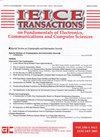具有新长度的交叉z互补对的新结构
IF 0.4
4区 计算机科学
Q4 COMPUTER SCIENCE, HARDWARE & ARCHITECTURE
Ieice Transactions on Fundamentals of Electronics Communications and Computer Sciences
Pub Date : 2023-01-01
DOI:10.1587/transfun.2023eap1075
引用次数: 0
摘要
空间调制(SM)是一种多输入多输出(MIMO)技术,与传统的MIMO系统相比具有许多优点。SM-MIMO以其独特的传输原理为特点,降低了成本,提高了频谱利用率,减少了信道间干扰。为了优化空间调制系统在频率选择信道上的信道估计性能,提出了交叉z互补对(CZCPs)作为训练序列。对于自相关和互相关和,czcp的零相关区(ZCZ)特性使它们能够获得最佳的信道估计性能。本文利用Turyn方法系统地构造了基于二进制Gary互补对和二进制Gary互补对的czcp。我们采用特殊的矩阵运算和串接方法得到了新的长度为2M + N和2(M + L)的czcp,其中M和L为二进制GCP的长度,N为二进制GCP的长度。进一步,我们得到了新长度为4N的完美CZCP,并扩展了CZCP的长度。本文章由计算机程序翻译,如有差异,请以英文原文为准。
Novel Constructions of Cross Z-Complementary Pairs with new lengths
Spatial modulation (SM) is a type of multiple-input multiple-output (MIMO) technology that provides several benefits over traditional MIMO systems. SM-MIMO is characterized by its unique transmission principle, which results in lower costs, enhanced spectrum utilization, and reduced inter-channel interference. To optimize channel estimation performance over frequency-selective channels in the spatial modulation system, cross Z-complementary pairs (CZCPs) have been proposed as training sequences. The zero correlation zone (ZCZ) properties of CZCPs for auto-correlation sums and cross-correlation sums enable them to achieve optimal channel estimation performance. In this paper, we systematically construct CZCPs based on binary Gary complementary pairs and binary Gary complementary pairs via Turyn's method. We employ a special matrix operation and concatenation method to obtain CZCPs with new lengths 2M + N and 2(M + L), where M and L are the lengths of binary GCP, and N is the length of binary GCP via Turyn's method. Further, we obtain the perfect CZCP with new length 4N and extend the lengths of CZCPs.
求助全文
通过发布文献求助,成功后即可免费获取论文全文。
去求助
来源期刊

CiteScore
1.10
自引率
20.00%
发文量
137
审稿时长
3.9 months
期刊介绍:
Includes reports on research, developments, and examinations performed by the Society''s members for the specific fields shown in the category list such as detailed below, the contents of which may advance the development of science and industry:
(1) Reports on new theories, experiments with new contents, or extensions of and supplements to conventional theories and experiments.
(2) Reports on development of measurement technology and various applied technologies.
(3) Reports on the planning, design, manufacture, testing, or operation of facilities, machinery, parts, materials, etc.
(4) Presentation of new methods, suggestion of new angles, ideas, systematization, software, or any new facts regarding the above.
 求助内容:
求助内容: 应助结果提醒方式:
应助结果提醒方式:


